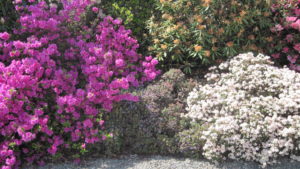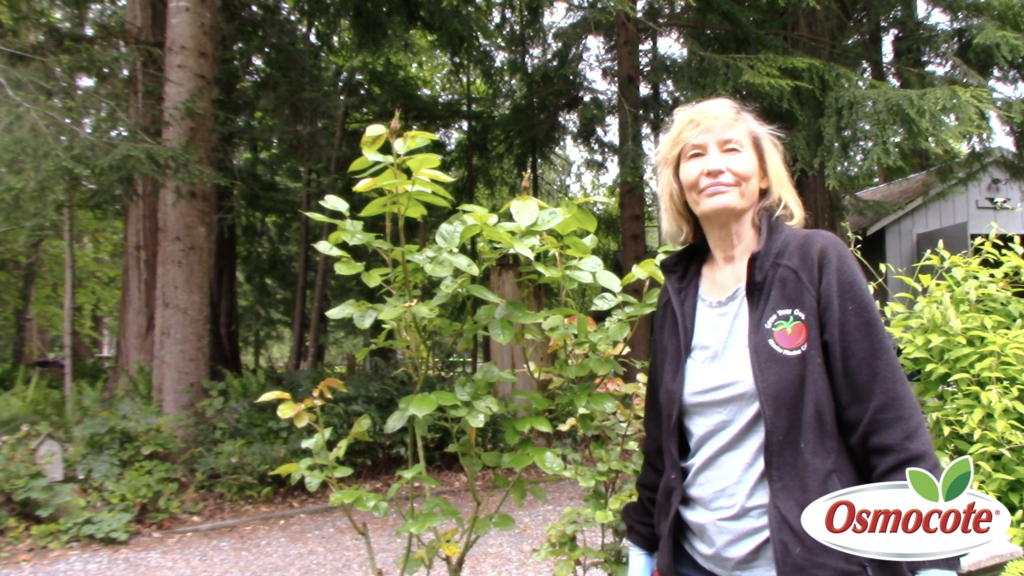Rhododendrons or “rhodies” are shrubby plants that can form beautiful framework of a flowering garden. There are thousands of varieties of rhododendrons in all sizes. Growing rhododendrons lights up the landscape with spectacular blooms throughout the spring and fall season. All azaleas are actually rhododendrons. (But all rhododendrons are not azaleas – got it?) Both the taller rhododendrons and the more compact azaleas can thrive with a few growing tips.
-
They love filtered shade – but they need some sun to bloom best
In general, growing rhododendrons with small leaves (like the PJM rhododendron) like more sun than large leaved rhododendrons. The north or East side of a building or fence is ideal. Try to avoid the dry soil under the eaves of the house. Rhodies love a woodland setting under the filtered shade of taller trees.
-
Give them acid soil – but no aluminum sulphate
In areas of high rainfall the soil will naturally be acidic and growing rhododendrons is easier. In dry climates you may want to do a soil test to be sure your soil pH (the measure of acidity) is between 4.5 and 5.5. Garden centers sell DIY soil tests that are easy to use. If your soil is not in the pH range to make rhododendrons happy you can make your soil more acid by adding pine needles, sphagnum peat moss or agricultural Sulphur to the soil at planting time.
Note: Do not use aluminum sulphate, often sold as a product that makes hydrangeas turn from pink to blue. It interferes with the growth of rhododendrons and azaleas.

-
Make sure you mulch – but don’t make volcanoes around the trunks
Rhododendrons have shallow, dense and thirsty roots. A mulch of wood chips, pine needles or compost will seal in moisture and slowly feed the plants. Use two to five inches of mulch on top of the roots but do not pile the mulch up around the trunk of the plants like a volcano. Pull the mulch a few inches away from the bark so that no mulch is touching the trunk. This helps to prevent disease and allows air into the soil.
-
Give them room – but protect from wind
The evergreen foliage of rhododendrons will dry out quickly if hit by warm summer winds and rhododendrons also suffer damage from cold winds in winter. Allow space for good air circulation between plants by planting two to five feet apart from other trees and shrubs. A sheltered spot near a hedge, clump of trees, fence or building will help to buffer those damaging winds and aid in growing rhododendrons.
-
Keep the soil moist – but don’t let roots set in water
In most gardens rhododendrons will need extra water in the summer. The soil must be kept moist year round. The secret to getting the “moist but well drained” soil that so many woodland plants love is to add organic matter to the planting area. Shovel and work into the soil up to 50% peat moss, compost or bark mulch. Mix this not just into the planting hole, but into the area three feet all around the shrubs.
When planting, dig a hole twice as wide as the root ball of the new plant. Rhododendrons can suffer from root rot if the soil is heavy clay or if the soil is in a low spot that collects water. If you need to check for good drainage, pour a bucket of water into the planting hole that you dig for your new plant. If the water disappears after a few hours, your soil is draining well.
-
Soak the root ball before planting – but don’t plant too deep
A few hours or the night before you add a rhododendron or azalea to your garden soak the entire root ball in water. Once you remove the container you can slice into the dense root ball few inches deep or score it with a trowel or knife to loosen up some of the fibrous roots. The planting hole should be twice as wide as the root ball with plenty of organic matter (compost, wood chips or sphagnum peat moss) worked into the soil. Set the top of the root ball about a 1/4 of an inch above the soil level. Planting too deep will suffocate the plant when growing rhododendrons. The mulch layer goes on top of this.

-
Summer Care means water, water, water – especially that first year as roots develop
The compact roots must be kept moist all year as these woodland shrubs lack a deep tap root. This is especially important every summer when next year’s blooms are formed. Use a drip system or patiently hand water to really soak the entire root ball. Adding organic matter when you plant and mulching on top of the soil will help to trap moisture but there is another tip you can use to indicate when to water in the summer: plant shade loving impatiens or lobelia under your rhododendrons. These thirsty annuals can act like canaries in a coal mine by wilting early to alert you when soil in the area is drying out.
-
Chose the right rhododendron for your area – but try new varieties
In warmer climates, azaleas do better than rhododendrons. Some varieties have repeat blooms in the fall, adding months to the flowering season. Many species of rhododendron are native to the United States. Finding out what grows best in your area can be as easy as noticing what is blooming beautifully in your neighborhood. You can snap a photo of a rhododendron in bloom to bring to a local nursery to find out the name of any variety you admire. Your local nursery will sell the varieties that do best in your climate including those species native to the region.
-
Know the mature size – but understand pruning
Rhododendrons and azaleas can be perfectly happy if you never prune them, or just prune to shape by occasionally removing wayward branches and dead wood. Large leaved varieties tend to grow the tallest, so give them room away from the house as they can grow to 15 feet. The more compact varieties such as the Yaks with small leaves are best for small gardens or as foundation plantings. For the most flowers practice pruning after blooming.
New growth sprouts from the point where any pruning cut is made. For growing rhododendrons, you can also snap off any faded flower clusters to tidy the shrub and keep energy from going to seed production. Drastic renovation of a mature rhododendron can be accomplished by pruning back to a stump – but then it can take up to three years for the patient to recover from the amputation. Better to remove one third of an overgrown rhododendron each year for three years. Azaleas can be sheared or trimmed immediately after they flower especially if you want a denser, hedge-like appearance. Japanese style pruning of azaleas is done after flowering by hand clipping to create globular cloud shaped shrubs.
-
Fertilize only when needed – but not too much.
Rhododendrons growing in the wild never need fertilizing so if you give these native shrubs soil with plenty of – you guessed it, organic matter they can thrive with no additional fertilizing on your part. The reality is that some soils are so thin that a spring application of a slow release plant food like Osmocote can provide the missing micro nutrients that rhododendrons and azaleas need for optimum growth. Rhododendrons with yellow leaves and green veins are suffering from a lack of iron so iron chelates will work like magic to green up the plants. Do not sprinkle any fertilizer near the trunk but instead apply at the drip line or where the branches end. Use a bit less not more than the amount recommended on the package.
Remember that growing rhododendrons and azaleas can be tricky with their sensitive fibrous roots. These roots not only dry out quickly, but can be easily burned from too much plant food. Cultivating near the roots of rhododendrons can also damage the roots so don’t work fertilizer into the soil with a fork, water it well instead.
Summary for Growing Happy Rhododendrons:
Lots of summer water, shade from the hot sun, protection from cold and drying winds and above all soil that is high in organic matter is what your rhododendrons need. Oh, and don’t forget to mulch!










